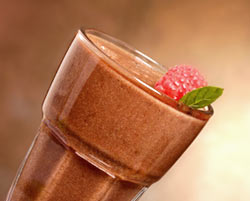Good news for Chocoholics - Healthy Life Essex
Fiona McDonald Joyce explains why certain types of chocolate can be beneficial to health
If you are wary of giving in to your chocolate cravings, relax – chocolate need not be banished totally from a healthy diet. In fact, it can be positively good for you! I am not talking about any old chocolate, however. It’s dark chocolate with a high percentage of cocoa solids (around 70%) which has been discovered to have a variety of health benefits.These include:
- High antioxidant content – raw cocoa has the highest antioxidant value of all the natural foods. Its ORAC (antioxidant rating) score per 100g is 28,000, compared to other so-called superfoods such as 18,500 for açai berries or 1,260 for raw spinach. As with any food, processing reduces the antioxidant content, but even so a typical 100g bar of
 dark chocolate still has an ORAC score of 13,120. Adding milk reduces this – a bar of milk or white chocolate has a much lower ORAC score of 6,740.
dark chocolate still has an ORAC score of 13,120. Adding milk reduces this – a bar of milk or white chocolate has a much lower ORAC score of 6,740. - Feel good factor – the amino acid tryptophan found in cocoa is converted into the ‘happy’ neurotransmitter serotonin by the body, while sister amino acid phenylethylamine boosts mood and helps us to concentrate.
- Heart healthy – dark chocolate has been shown to actively lower high blood pressure, as reported by scientists at the University of Cologne. It also contains substances called flavonols which prevent fatty substances from clogging arteries and reduce stickiness in blood platelets, lowering the risk of clots, strokes and heart attacks.
Of course, if chocolate triggers migraines or an allergic response, do avoid it. But for those who can tolerate it, these recipes can help you make the most of the benefits of dark chocolate in combination with other healthy ingredients.
A mouthwatering cheesecake that is also surprisingly nutritious, with no added sugar and plenty of fibre, minerals and essential fats. Serve with berries.
Serves 8-10.
For the base
100g (4oz) unsalted nuts and/or seeds
(hazelnuts, almonds, walnuts, Brazil nuts and sunflower seeds all work well)
100g (4oz) rough oat cakes
50g (2oz) coconut oil or butter
30g (just over 1oz) xylitol
For the filling
400g (14oz) dark chocolate, broken into chunks
375g (13oz) plain cottage cheese
300g (11oz) natural yoghurt
2 free-range egg yolks
4 free-range egg whites
- Preheat the oven to 160C/325F/gas mark 3. Line a 20cm/8in loose-bottomed cake tin with baking paper.
- Place the base ingredients in a food processor and whiz until the consistency of coarse breadcrumbs. Press firmly into the bottom of the lined cake tin using the underside of a metal tablespoon, so that it covers the base evenly. Bake for 10 minutes then set to one side to cool.
- Meanwhile, melt the chocolate over a bain-marie (as right) or in the microwave. Set to one side while you prepare the rest of the filling.
- Blend the cottage cheese, yoghurt and melted chocolate until smooth then quickly blend in the egg yolks.
- Beat the egg whites until they form stiff peaks then gently fold them into the chocolate mixture until evenly blended. Pour into the cake tin and cook for around 1–1.5 hours, or until the top is just firm to the touch. Allow to cool on a wire rack then chill before serving.
You will notice that this recipe uses no cream or butter. Make the day before to set overnight. Serve it with fresh berries for added vitamin C and flavonoids. Serves 4.
180g (just over 6oz) good quality dark chocolate, broken into pieces.
(around 60% cocoa solids – if it is too dark it will overpower the flavour of the orange)
150ml (1/4 pt) freshly squeezed or pure (no added sugar) orange juice
(equivalent to the juice of 2 large oranges).
6 medium free-range eggs, separated.
- Melt the chocolate over a bain-marie (half fill a saucepan with water and let simmer. Place the chocolate in a heat proof bowl on the saucepan, making sure the base of the bowl does not touch the water, and let the chocolate gently melt over the heat), or in a microwave.
- Add the juice to the bowl and cook with the chocolate over a gentle heat until it forms a creamy consistency. This takes quite a long time and the mixture won’t get very thick, but it should be fairly gloopy and move slowly when running over the back of a spoon.
- Remove from the heat and beat in the egg yolks (one at a time).
- Beat the egg whites until they form stiff peaks then gently fold a spoonful into the chocolate mixture to loosen it, using a metal spoon so as not to knock out all of the air. Gently fold in the rest of the egg whites and carefully spoon the mousse into a large bowl and place immediately in the fridge to set.
Health note: Because this recipe contains raw egg, always choose organic or at the very least free-range eggs to reduce the likelihood of salmonella contamination, and do not serve to pregnant women, very young children, the elderly or infirm.
For more healthy and delicious recipes, see The Holford Low GL Diet Cookbook, Smart Food for Smart Kids and Food Glorious Food.
Fiona Mcdonald Joyce trained at both Leith’s School of Food and Wine and the BANT accredited Institute for Optimum Nutrition. She co-authored The Holford Low GL Diet Cookbook with Patrick Holford. Fiona works with Patrick Holford, lecturing on ‘low GL’ food and creating recipes following optimum nutrition principles.
 This article has been reproduced courtesy of Patrick Holford www.patrickholford.com. This article has been reproduced courtesy of Patrick Holford www.patrickholford.com.
Members of Patrick’s 100% Health Club receive regular articles like this. Click here for more info. This article first appeared in the March 2008 newsletter. |
Picture Credits
“girl eating chocolate” © Photographer:Serghei Starus | Agency: Dreamstime.com
“Chocolate Cheescake” © David Smith | Dreamstime.com
“Chocolate Orange Mousse” © Tracy Hebden | Dreamstime.com

